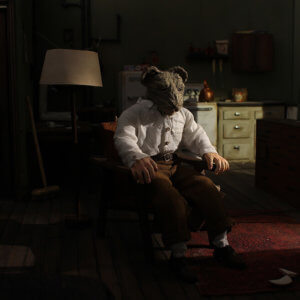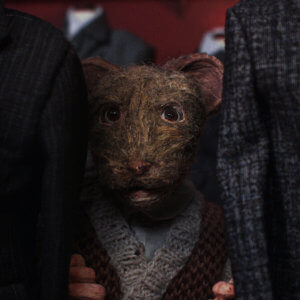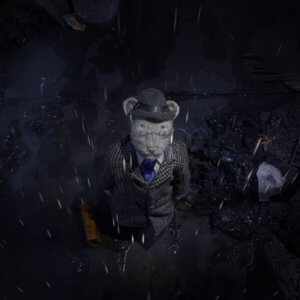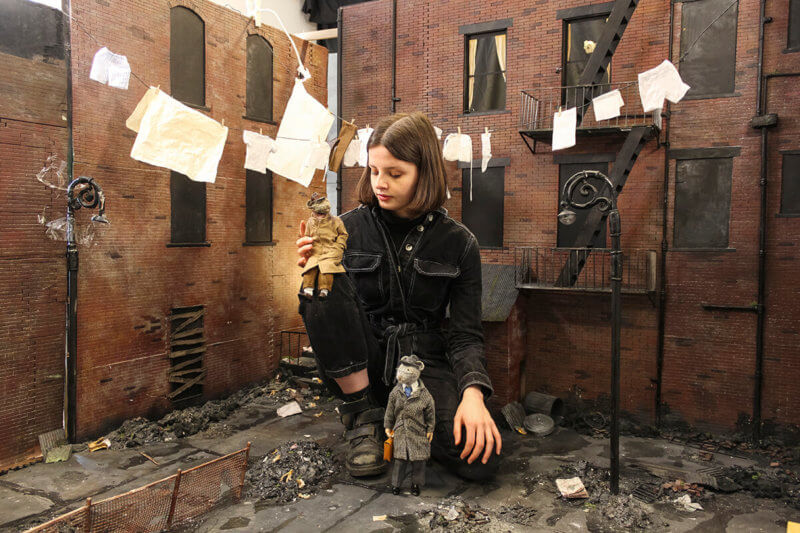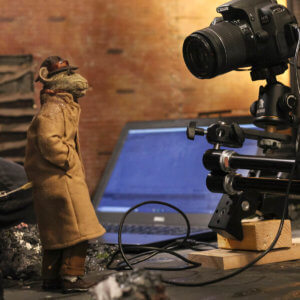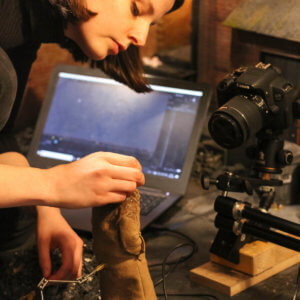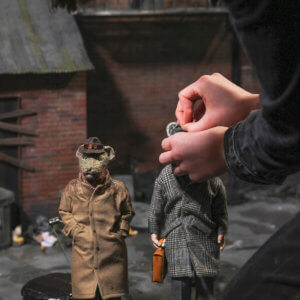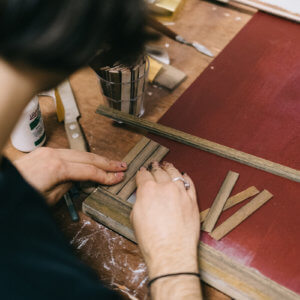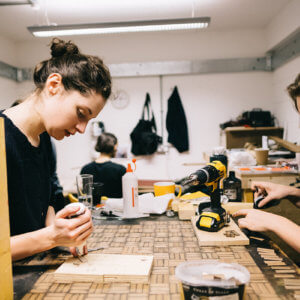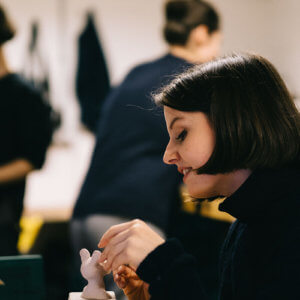‘The Fabric of You’ – Josephine Lohoar Self Interview & Review
Josephine Lohoar Self’s, “The Fabric of You” is a heartfelt portrayal of the severe grief suffered by Michael after he loses his lover Isaac. Set in the 50s, Michael is a quiet seamstress, an anthropomorphic mouse who resides in the Bronx. Isaac enters his life as an inquisitive customer who admires and appreciates the craft and skill that Michael puts into his garments. They have a warm conversation about fashion, the contrast between hiding and expressing. The theme of identity is raised throughout the film. In the character design; human bodies with mouse heads almost like they’re wearing masks. The uniformed trench coat, trilby hat style of the 50s shows the need to conform. In the end scene Michael puts on Isaac’s coat as he goes to reconcile himself to him. The tender display of two men in love pushes against the constraints of their society and is a much needed take on sexuality in that era.
I enjoyed the non-linear structure, the way we flow back and forth from Michael’s life to his memories. It feels real, the way seeing ordinary objects like a kettle, a button, a sewing machine or jacket can spark off memories and make us relive our past moments. Michael’s grief is inescapable and even his happy memories are tainted with the stinging reminder that Isaac is dead. The travelling back and forth in time makes me unsure whether I’m in the present or past, emulating the whirling feelings of Michael, who’s fixated on what he’s lost. The style of this film is interesting as on first glance the fuzzy stop-motion mouse reminds me of a children’s character similar to “Fantastic Mr Fox” or “Wind in the Willows”. In this way it subverts expectations and might make the film even more impactful. The animation performance style has an elegant subtlety that reminds me of Kaufman’s, “Anomalisa”, another stop-motion film that deals with complex, mature themes.
The intricate puppets, costume and set support the story well and have a tangible and textural feel. I buy into the world and go with it easily. The soundtrack adds to the cinematic tension and blends subtly Michael’s memories with his current situation. It’s a sensitive film that expresses very earnestly the insatiable longing to be reunited with those who are gone. The ending of the film doesn’t offer hope and I admire the integrity of a film that has no happy ending. Before grief and death, there was life and love; this film captures the overwhelming feelings that come with both.
Interview with director, Josephine Lohoar Self
How did the idea for ‘The Fabric of You’ start?
Two years ago, I read the critically acclaimed graphic novel ‘Maus’ by Art Spiegelman and was incredibly moved by its portrayal of Spiegelman’s father’s experience in the Holocaust. In the novel Spiegelman portrays Jewish people as mice and Nazi Germans as cats, in a highly stylised postmodern style. ‘Maus’ exposed me to the world of graphic novels and demonstrated the power ‘book-form’ graphic novels could have.
A theme which I look to explore in my work is how the past and present interweave. ‘Maus’ moves between two timelines. In the narrative present, Spiegelman interviews his father – Vladek, about his experiences in the Holocaust, and the narrative past we see these experiences play out. Vladek experiences pan from the lead up to World War II to the liberation of the Nazi concentration camps.
Taking inspiration from ‘Maus’, I wanted to write a story which explored grief while using a narrative weave.
For the setting of the film I took inspiration from Will Eisner epic graphic novel ‘A Contract with God’ which revolves around a poor New York City tenement. Having lived in tenement blocks myself, Eisner masterfully creates atmospheric drawings of the confined tenement spaces in which his characters live. I based the set of ‘The Fabric of You’ on Eisner’s drawings, as well as Hitchcock’s film ‘Rear Window’. I wanted the confined environment to reflect Michael’s (our main protagonist) grieving mental state.
What made you decide that the characters would be mice?
I found Spiegelman’s approach to telling his father’s story through anthropomorphic mice incredibly effective. Spiegelman’s depiction of Jew’s as mice was highly politicized. Deriving the mouse as a symbol for the Jew from Nazi propaganda he wanted to emphasis the absurdity of dividing people along such lines.
For me I wanted to use the animal of a mouse to best reflect my protagonist’s personality while also emphasising the bleak, hovel-like living situation he finds himself in. Similar to ‘Animal Farm’ by George Orwell, animals can symbolize and reflect elements of human behaviour often far better than human characters can.
Do you have many influences or inspirations for your work?
I get my inspiration from a variety of places before I begin on a script. I’m always working in a way – gathering ideas from short stories people tell me, photographers, paintings, films and real life.
I’ve always been a big fan of European film makers such as Gaspar Noé, Michael Haneke and Lynne Ramsay. I really enjoy films which are provocative and challenge the complicity of the viewer. At the moment I’m obsessed with two of Pawel Pawlikowski’s films – ‘Ida’ and ‘Cold War’, which are breathtakingly beautiful.
- Photos by: Marilena Vlachopoulou
Was it difficult working on a project with such a heavy subject matter?
I tried very hard to approach the topic of grief with sensitivity. I was fortunate enough, during the development stage of the project to have had a really great executive producer. Together we interrogated and challenged certain elements of the script, while drawing on our own experiences.
I also think it’s important to try and inject elements of humour whenever you’re dealing with heavy subject matters. I found that even in dire circumstance people still manage to find humour. I think it temporarily lifts people’s burden of grief and adds some normalcy to the situation. Speaking from a narrative angle too, when you inject humour before a sad scene it can amplify the heartbreak. The audience have already opened up emotionally, only to be punched in the gut with something stronger! (the recent film ‘JoJo Rabbit’ is a great example).
- Photos by: Euan Robertson
Do you have any other projects lined up that you can talk about?
I’m really excited about a new script I’ve written for another short stop motion film. At the moment we’re pitching it to funding bodies, so fingers crossed you’ll hear something positive from me later this year. 111
I’ve also got a live action script in the works. I’m really looking forward to translating what I’ve learnt from working in stop motion animation into a live action. Although it’ll present new challenges, I’d like to think I can bring my strong eye of detail and visual strengths to the project.
You can follow the work of Josephine by following her on Instagram, or checking out her online portfolio.


